Solar arrays cannot always occupy a customer’s rooftop, but ground-mount systems might not be the only other backup option in these cases. Wall-mounted, vertical panels are still an energy-generating option for solar installers.
Installers have adapted pre-existing mounting and racking technology or developed their own to install solar panels on the south-facing walls of buildings. Customers must be willing to take a slight cut in energy production, but they can up the aesthetic value of their buildings if they opt for a vertical, wall mounted solar array.
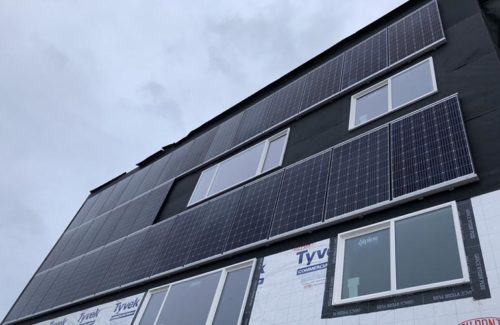
Arctic Solar Ventures of Anchorage, Alaska, regularly installs solar panels on south-facing walls of buildings. While they do not produce as much as their roof or ground-mounted counterparts, vertical panels are easier to maintain in some rights. Arctic Solar Ventures
“It demonstrates to the world that we have a solar system,” said Gerry Heimbuch, partner at solar installer Quixotic Systems. “If it’s on the roof, you don’t really see it.”
In certain cases, especially on commercial buildings, the flat roof space is already occupied by vents and other equipment, which may prevent a worthwhile solar array. For densely populated areas like New York City, ground-mount solar isn’t really an option. Some houses have aging or damaged roof coverings or cannot structurally handle a rooftop array, warranting a wall installation. Or maybe a customer isn’t physically able to get on their roof to maintain an array (which installers don’t recommend in the first place) and would rather have it reachable on an outside wall.
Arctic Solar Ventures of Anchorage, Alaska, started mounting panels vertically to boost production in the wintertime. The installers use all-black hardware to encourage snowmelt, and the vertical positioning prevents snow accumulation.
Vertical mounts can be advantageous for installers in northern latitudes due to short days where the sun remains in the southern skies. The same is applicable to horizontal roof mounts in Alaska, because “the sun’s basically overhead all summer,” said Arctic Solar Ventures CEO Stephen Trimble. The company uses the original Unirac SUNFRAME in vertical solar installations. The vertical mounts can accompany flush, horizontal mounts on rooftops.
“It’s kind of the idea that you can have a lot of low-angle rooftop modules that produce very well with our high-angle sun,” he said. “We always do our rooftop arrays flush, and then you can have a few modules mounted vertically that boost your winter production when the sun’s very low on the horizon, and it works out great.”
Solar panels will receive optimal exposure when mounted on a rooftop compared to a wall. But Trimble estimated a vertical solar array still produces about 70% as much as a sloped or flat roof system. And in the wintertime snow doesn’t accumulate atop the panels, but system owners should be wary of ice buildup behind them.
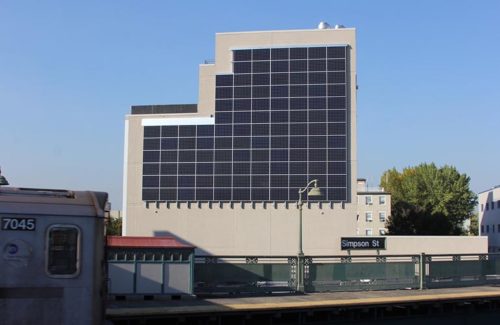
Quixotic Systems has installed solar panels on walls of buildings in New York City, where open roof space and land can be difficult to come by. Installers have erected scaffolds to scale the sides of tall buildings in order to build vertical arrays. Quixotic Systems
Quixotic Systems of New York City installs wall-mounted arrays parallel with walls, with about a 6-in. gap between the panel and the building to prevent buildup. The company’s first vertical solar project was a 37-kW array on the wall of Urban Health Plan’s Simpson Pavilion in the Bronx. Quixotic found that there wasn’t ample rooftop space to meet the energy demands of the hospital, nor was there available land for a ground-mount array.
“There was a lot of convincing going on because it’s a big construction effort to design and build something of that scale on the side of the building and hopefully have it stay there for 25 years,” Heimbuch said. “It’s new territory for everybody.”
That Bronx hospital array was installed using a custom-designed mounting system with extrusion from Schletter. Quixotic had to build scaffolding to navigate the south-facing wall of the stories-high building. Heimbuch said the disadvantages of a wall-mounted, vertical solar array outnumber the advantages, “but it’s used in the case where you have no other choices and the client needs to have renewable energy in the building.”
Depending on the condition of the building, vertically-mounted solar panels can be mounted with similar penetrations as pitched rooftops. Installers can attach racking to vertical support beams. If drilling into the wall isn’t an option, installers have placed two-by-four wooden planks for supplemental mounting surfaces instead.
“One of the biggest things you have to consider is how you are going to maintain the system if in fact something fails over the course of 25 years,” Heimbuch said. “Accessibility is obviously a big thing, because the last thing you want to do is rebuild a scaffold in order to fix a problem. We took a lot of time and effort in designing this thing so that we could get access to critical components.”
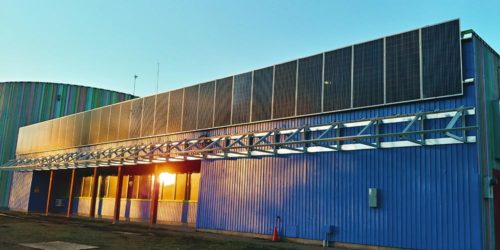
Vertical solar modules were installed above awning panels at Eugene Science Center in Eugene, Oregon. Everybody Solar was set to start an array at the science center when installers realized the roof wasn’t structurally sound for rooftop solar. Everybody Solar
Youness Scally, executive director of Everybody Solar, said it’s important to keep in mind that municipalities will have different regulations for mounting objects to exterior walls. Consider contacting city inspectors to ensure the vertical mounting methods are up to code.
An ongoing installation at Eugene Science Center in Eugene, Oregon, warranted vertical panels along the building’s south-facing wall. When funding was secured and installers were on the rooftop for the first time, they realized that it wasn’t structurally sound to hold solar panels. Working on a deadline with grant funding, Everybody Solar found a workaround, completing the first phase of the 32-kW array with wall-mounted awnings and vertical panels.
“It was not our initial design at all,” Scally said. “The roof was not suitable for solar, so that’s what made us reconsider what was going to happen. We still needed to complete the project.”
The vertical panels are mounted above the solar awnings to prevent any shading. Without the wall as an option, Everybody Solar might not have completed that phase of the project.
“It’s good to know about [wall mounts] as part of a tool set if we run into some more problems in the future,” Scally said. “We try to make sure the roof is good to go, but some of these projects take us six months to a year to get off the ground, and when you’re there and then find out the roof isn’t going to work, we have another way to accomplish end goals — to get panels producing solar energy.”

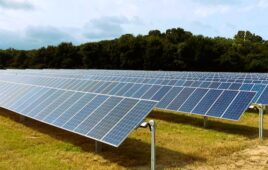
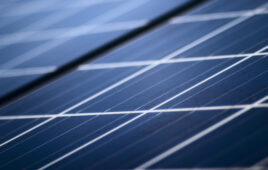
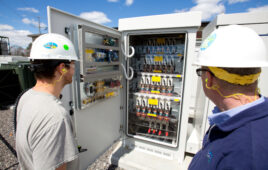
i have a vast south facing greenhiuse .I cannot have solar on the roof but whow about the very tall brik walls???
Our passive solar house has a fairly steep, north facing roof not suitable for solar. How much weight would solar panels put on the exterior wall made of shiplap?
Retrofits could benefit from vertical installation where the cladding is replaced with integrated in-roof panel mountings. Module sizes, edge weather seals and aesthetics need to be considered. I suspect that panels and solar tiles fitted like shingles will become much more common treatments for upper walls in city and inner urban areas. And they offer the benefit of reflecting light to previously shaded sides of adjacent properties – helping gardens to survive.
Instead of awnings on the sunbaked side of my 1940s red brick home, wouldn’t it be possible to just hang a massive solar panel that provided shade to two stories of windows.
Can this panels system be used as cladding in place of the exterior wall? We have an existing exterior wall steel structural system. Can the solar panels be install into a secondary framing system and function as the actual cladding?
I actually thought this might be in the article as surely someone has thought of a solution with reduces heat loss + solar energy.
Great reminder to do a site check way BEFORE installation day.
Hanergy powerful lightweight Flex Panels would have been a better solution since they are ideal for roofs that cannot bear the weight of conventional panels.
Outstanding work guys! With 30% less production in comparison to rooftop solar arrays, not too bad as long as involved customers sign off on vertical solar arrays.
It is an awesome idea, thanks and good luck guys.